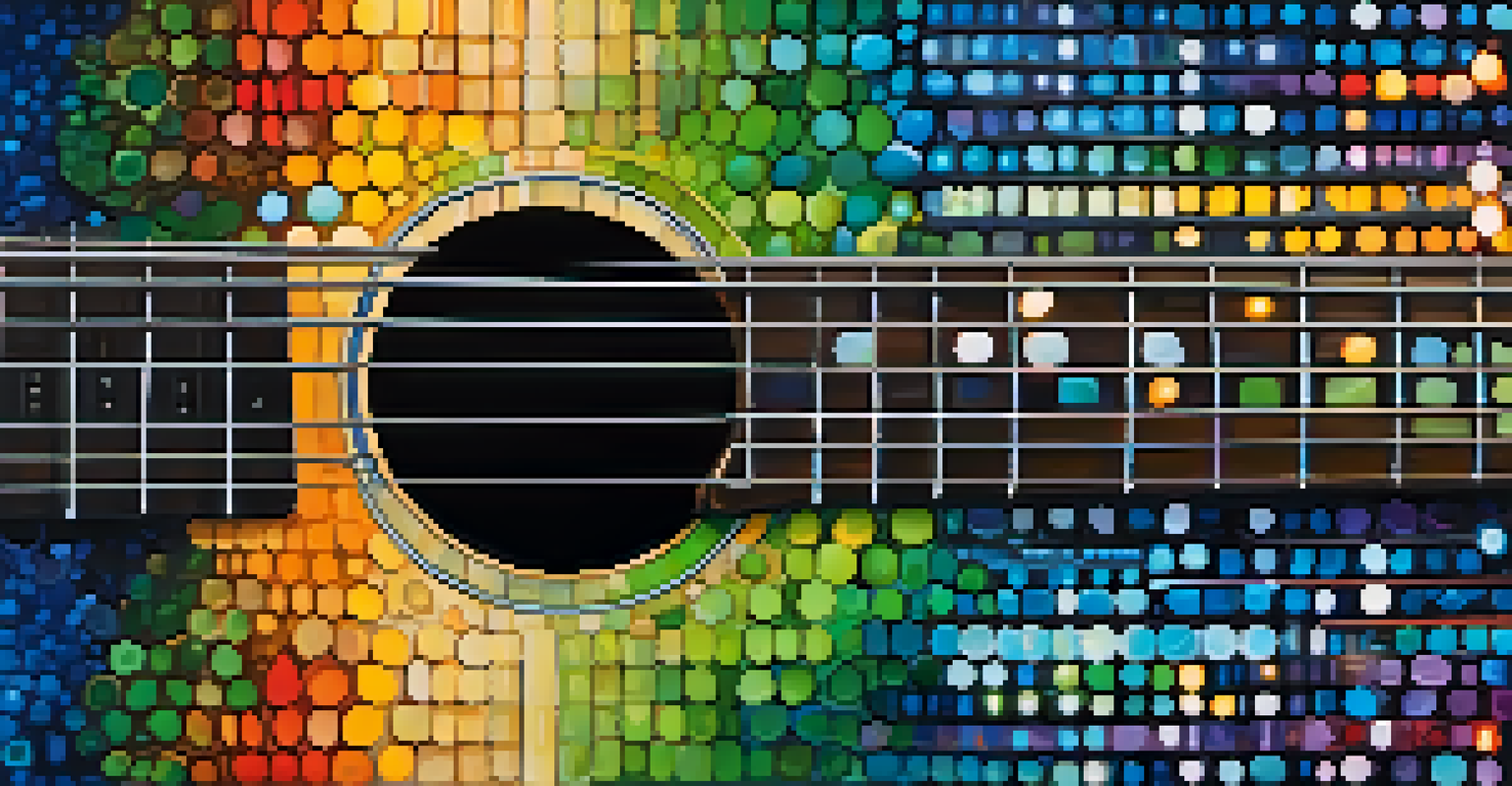Guitar Scale Patterns: Building Blocks for Improvisation

Understanding the Role of Guitar Scale Patterns
Guitar scale patterns serve as the foundation for improvisation. They provide a structured way to navigate the fretboard and create melodies. Think of them as a map that guides you through various musical landscapes.
Music is the shorthand of emotion.
When you understand scale patterns, you can easily access different notes and create harmonious sounds. They simplify the process of improvisation, making it less daunting for beginners and advanced players alike. Imagine being given a set of keys to unlock a treasure chest of musical possibilities.
Moreover, these patterns are versatile; they can be applied across various genres. Whether you're jamming in a blues session or experimenting with jazz, scale patterns will help you express your musical ideas more freely and creatively.
The Major Scale: Your First Step to Improvisation
The major scale is often the first scale guitarists learn, and for good reason. It consists of seven notes and has a bright, happy sound. By mastering this scale, you set a solid foundation for improvisation that will serve you throughout your musical journey.

Practicing the major scale in different positions on the fretboard is crucial. It allows you to become familiar with how the notes relate to each other, much like learning the alphabet before writing sentences. Try playing the scale in different octaves to see how it sounds and feels.
Mastering Scale Patterns is Key
Understanding and practicing scale patterns form the foundation for effective improvisation on the guitar.
Once you’re comfortable with the major scale, you can start experimenting with melodies. Use the notes from the scale to craft your own musical phrases, and don’t be afraid to mix it up! This experimentation is where your unique style will begin to emerge.
Diving into the Minor Scale Patterns
After mastering the major scale, the next logical step is exploring the minor scale patterns. The minor scale offers a more somber, introspective sound, which is perfect for expressing deeper emotions in your playing. Think of it as the 'moodier' sibling of the major scale.
Imagination is more important than knowledge. For knowledge is limited, whereas imagination embraces the entire world, stimulating progress, giving birth to evolution.
Minor scales also consist of seven notes, but their intervals create a different tonal quality. Learning these patterns will help you access a variety of musical flavors and expand your improvisational palette. It’s like adding new colors to your artistic toolkit.
As you practice the minor scales, try to incorporate them into your improvisations. Use them in contrast with major scales to create tension and release in your music. This interplay between major and minor can lead to captivating musical moments.
Exploring Pentatonic Scale Patterns for Versatility
Pentatonic scales are widely used in various genres, especially rock and blues. These five-note scales simplify improvisation and allow for expressive playing without the potential 'clashes' of a full seven-note scale. It’s like having a simplified recipe that still tastes amazing.
The beauty of pentatonic scales lies in their adaptability. You can use them over major or minor chords, giving you a lot of freedom in your improvisation. Experimenting with these scales can lead to some of the most memorable riffs and solos.
Experiment with Major and Minor Scales
Blending major and minor scales in your playing can create unique sounds and enhance emotional expression.
Try breaking down pentatonic patterns into smaller sections and practice them across the neck of your guitar. This will enhance your finger dexterity and help you develop your own improvisational voice. You'll find that these patterns can inspire a fresh wave of creativity.
Combining Scale Patterns for Unique Improvisation
Once you’re comfortable with various scale patterns, the fun part begins: combining them! Mixing different scales can produce unique sounds and styles, allowing you to express your musical identity. It’s akin to a chef experimenting with flavors to create a signature dish.
For instance, try blending major and minor pentatonic scales in your solos. This mixture can create an intriguing contrast that captivates listeners. It not only showcases your technical skill but also demonstrates your creative approach to improvisation.
Experimentation is key here. Don’t be afraid to step outside traditional boundaries and see where your musical curiosity takes you. Each combination can uncover new melodies and ideas that resonate with your audience.
Practicing Scale Patterns Effectively
Effective practice is essential for mastering guitar scale patterns. Start slow, focusing on accuracy rather than speed. Building a strong foundation will pay off in the long run, just as a solid structure is vital for any building.
Use a metronome to help keep a steady tempo and gradually increase your speed as you become more comfortable. Break down each scale into manageable sections, and practice them in various positions on the fretboard. This approach allows you to develop muscle memory and familiarity with the notes.
Effective Practice Enhances Skills
Consistent, focused practice with real-world application is essential to mastering guitar scale patterns and improvisation.
Additionally, incorporate your practice into real musical contexts. Play along with backing tracks or jam with friends to apply what you've learned. This real-world application will not only reinforce your skills but also make practicing more enjoyable.
Incorporating Improvisation into Your Playing Style
Improvisation is an essential skill that can take your guitar playing to the next level. Incorporating it into your style can make your performances more engaging and dynamic. Think of it as adding a splash of improvisational paint to your musical canvas.
Start by using the scale patterns you’ve learned to create spontaneous melodies during your practice sessions. This will help you become comfortable with improvisation and develop your unique voice as a guitarist. Remember, it’s all about self-expression and creativity.

As you grow more confident, don’t hesitate to take risks during performances. Embrace the unexpected moments and let your musical intuition guide you. This authenticity will resonate with your audience and elevate your overall playing experience.